The Brief – Extensive Mould Growth
We were called to a modern apartment, located on the second floor of a purpose built tower block in South East London. Built circa 2011, the property consists of two bedrooms, a bathroom, and an open plan kitchen/lounge. The client was experiencing mould growth so we attended site to investigate the extent of microbial growth and whether any mould removal 215mm thick dry lined walls with plasterboard to both sides, and the internal walls are made from 12.5mm on metal stud work frames. We expected to find thermal insulation (Rockwool or similar) within the wall. The ceilings also consisted of 12mm plasterboard on metal stud frame, which is fixed to the concrete ceiling above.
When we attended site, the exact construct of the floor was unknown, but but based on the age of the property, we expected it to be built of pre-cast concrete slab, 50–75cm sand cement screed coated with self-levelling compound, finished with various floor coverings depending on the room. We also expected thermal insulation or acoustic membrane to be present between the screed and pre-cast concrete slab.
The Objective – Mould Removal
Upon our arrival, we were informed by the client that the water supply connection to the cistern in the ensuite has been leaking. The toilet is enclosed within boxing, therefore, the leak was not noticed until signs of water damage and microbial (mould) growth started appearing in the hallway, the hallway cupboards, and the master bedroom. The leak was subsequently fixed by a third party prior to our attendance, and our services as a mould removal company were now needed.
Damage Caused
Ensuite
- Heavy mould contamination to the plasterboard within the boxing behind the toilet
- Water damage to the lower walls
Master Bedroom
- Staining and microbial growth to the lower wall which divides the master bedroom and ensuite
- Blown MDF skirting board on the wall dividing the master bedroom and ensuite
- Microbial growth on the carpet grippers and carpet beneath the vinyl floor covering
Hallway
- Staining and microbial growth to the lower wall dividing the hallway and the boiler and storage cupboards
- Blown MDF skirting boards
- Blown doors to the boiler cupboard
Boiler Cupboard
- Blown MDF skirting board
- Staining and microbial growth to the lower walls
Storage Cupboard
- Heavy mould contamination to plasterboard walls
- Blown MDF boxing and skirting board
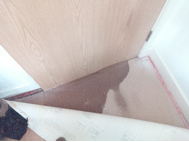
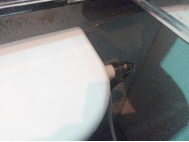
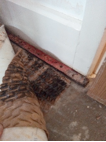
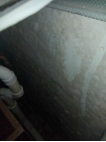
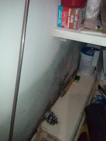
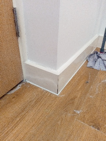
Upon arrival, we took atmospheric readings, which registered as follows:
| Relative Humidity | Temperature | Dewpoint | Specific Humidity | Vapour Pressure |
|---|---|---|---|---|
| 43.1% | 29.7°C | 15.9°C | 11.08g/kg | 1.76kPa |
These readings help us to evaluate several things, including whether there is a risk of secondary damage to hygroscopic materials (eg. wood and plasterboard) due to high levels of moisture in the air. Hygroscopic materials can absorb water vapour from the air, increasing the amount of water they’re holding at a given time. As such, this can lead to further issues, including microbial (most commonly mould) growth.
As well as taking atmospheric condition readings, we also completed a moisture survey which gave us the readings as detailed in the chart below.

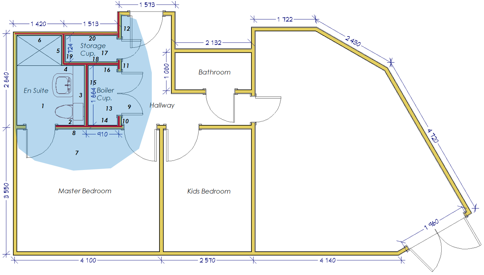
As you can see from the chart above, we recorded readings of up to 999 REL and 100% WME in multiple locations—these are the maximum readings possible. Such high moisture levels will accelerate the speed of mould growth in the affected areas and beyond if no action is taken. And as we mentioned earlier, we had noted mould growth in a number of locations already.
The Technical Part
There are many hundreds of mould varieties, each requiring different levels of water activity to allow them to develop and flourish. The lowest known level of water activity in which mould can be active is 0.61; in general, this level collates to an atmospheric relative humidity of 60%. Note: Normal range is considered around 40–50%.
Mould is a simple fungi from several groupings in the fungal classification system. Sexual reproduction in some fungi allows genetic modification to adopt and tolerate changes in the environment, such as humidity, temperature, and food requirements.
There are three principal features common to the broad range of mould:
- Simple food requirements: Mould is able to exist on non-nutrient materials such as plaster and brick which have traces of contaminating organic matter.
- Produce vast number of spores which allow rapid adaptation to particular environments, conditions, and rapid colonisation of other suitable locations within an enclosed environment.
- Grow very quickly under suitable conditions: The main requirement for the development and growth is a source of moisture, although food, oxygen, and a suitable temperature are also important.
Moulds can be regarded as hydrophilic fungi (tolerating high water availability), although individual species have their own optimum requirements for moisture. In most situations where surface condensation occurs and/or the relative humidity of the internal atmosphere exceeds 70% for an extended period, mould growth will be established.
Based on our inspection of the property, which required a mould removal London service, the client had to be moved into alternative accommodation while we carried out the following mould remediation work:
General
- Complete air sampling throughout the property to establish levels of contamination
- Examine contents for evidence and establish levels of cross-contamination
- Move the contents identified as contaminated to alternative accommodation and move unaffected contents to the open plan kitchen/lounge area.
- Seal off the unaffected areas to prevent cross-contamination
- Install a negative pressure system and scrubbers before the enabling work begins
Enabling Work
Ensuit
- Remove all sanitary units
- Remove boxing behind the toilet
- Remove wall tiles around the shower cubicles
- Removed exposed contaminated plasterboard
- Remove insulation from wall cavities
- Remove floor tiles
- Remove tile adhesive
Master Bedroom
- Remove skirting board from the affected wall
- Remove contaminated plasterboard
- Remove insulation from wall cavities
- Remove vinyl flooring
- Remove carpet, underlay, and carpet grippers
Hallway
- Remove skirting board from affected wall
- Remove contaminated plasterboard
- Remove insulation from wall cavities
Boiler Cupboard
- Remove skirting board from affected wall
- Uplift laminate flooring and underlay
- Remove contaminated plasterboard
- Remove insulation from wall cavities
Storage Cupboard
- Remove skirting board from affected wall
- Uplift laminate flooring and underlay
- Remove exposed contaminated plasterboard
- Remove insulation from wall cavities
Decontamination
- All affected rooms to be cleaned using our four-stage mould remediation process
- Complete Biosweep treatment to all affected rooms
Once decontamination works were complete, we dried all the affected areas using turbines, floor piping kits, and adsorption dehumidifiers. Based on the moisture levels while on site, we estimated drying to take between 21 and 28 days.



